Books by Florian Réveilhac
The LGPN-Ling Search website now open goes hand in hand with the printed publication of the Lexon... more The LGPN-Ling Search website now open goes hand in hand with the printed publication of the Lexonyme. Dictionnaire étymologique et sémantique des anthroponymes grecs antiques, planned in 3 volumes (vol. 1: A-E, 2023, Droz, Geneva, coll. Hautes études du monde gréco-romain), and intended to replace Die historischen Personennamen des Griechischen bis zur Kaiserzeit by Fr. Bechtel (1917).
Papers by Florian Réveilhac

Contacts linguistiques en Grèce ancienne. Diachronie et Synchronie, 2024
The full article can be read here: ⟨https://hal.sorbonne-universite.fr/hal-04542324v1⟩.
In Lyci... more The full article can be read here: ⟨https://hal.sorbonne-universite.fr/hal-04542324v1⟩.
In Lycia, an area of language contact especially between Lycian and Greek, indigenous personal names were subject to different strategies of adaptation from the source language to the target language (proper loanword, assimilated loanword, loanshift and cover name). Following seminal works in other contact areas of the Greco-Roman world, this contribution examines the question of Lycian-Greek cover names, i.e. that can be interpreted as Lycian and Greek at the same time. Firstly, it aims to establish identification criteria for these personal names, taking into account the specificities of the Lycian area. It then proposes, through the study of specific cases, a typology of Lycian-Greek cover names which takes into consideration both the point of view of the source language and that of the target language.
Journal of Language Relationship • Вопросы языкового родства, 2023
This article extends and discusses a study by M. Valério (2015), which deals with several groups ... more This article extends and discusses a study by M. Valério (2015), which deals with several groups of personal names from southern Anatolia. It is proposed here to reconstruct one onomastic stem, *tubar(i)-, common to several names from different language corpora belonging to the Luwic subgroup (Luwian, Carian, Pisidian) and Greek epigraphic sources from southern Anatolia (from Caria to Cilicia). This prolific element is associated with various divine names or epithets in compounds, which suggests that it corresponded to a divine title. Its meaning can be reconstructed as "battle companion, comrade-in-arms", originally qualifying various deities whose role was to guard their protégé on the battlefield.
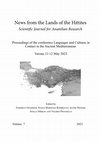
News from the Lands of the Hittites, Scientific Journal for Anatolian Research (Proceedings of the conference Languages and Cultures in Contact in the Ancient Mediterranean, Verona 11-12 May 2023), 2023
This article investigates the question of names in °ασητας/°ασατης/°ασατας attested in Greek sour... more This article investigates the question of names in °ασητας/°ασατης/°ασατας attested in Greek sources from southern Anatolia. The equation with Luwian theophoric names in /°tsid(i)-/, long defended, is not possible for undeniable phonetic reasons. Thanks to the comparison with simple names attested in the Lycian, Pisidian and Greek corpora, it is suggested here to identify an onomastic stem °ασητας/°ασατης/°ασατας, adapted from an abstract noun corresponding to Luw. *aššatta-, Lyc. B *asata- and Lyc. A ahata-, and associated with several deities as an epithet. The various vocalisms attested in Greek sources are geographically distributed, thus reflecting differences among languages of the Luwic subgroup. On the semantic level, the contexts in which the abstract *aššatta-/*asata-/ahata- is used argue in favour of the meaning of “peace”, despite its recent questioning.
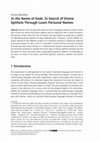
What’s in a Divine Name? Religious Systems and Human Agency in the Ancient Mediterranean (open access), 2024
Recent work on personal names in Luwic languages (mainly Luwian, Lycian and Carian) has shown tha... more Recent work on personal names in Luwic languages (mainly Luwian, Lycian and Carian) has shown that divine epithets play an important role in their formation. The present article takes this line of inquiry one step further by proposing a method for identifying divine epithets in these anthroponyms. Theonym + divine epithet formulae attested in the different corpora are sometimes directly or indirectly reflected in personal names. In other cases, it is possible to restore divine onomastic formulae through personal names thanks to a combinatorial analysis and parallels. It is then provisionally proposed to identify five main types of divine epithets entering into the formation of Luwic personal names: geographical epithets, epithets corresponding to the place of action of the deity, functional epithets, laudatory epithets and divine titles.
Kadmos. Zeitschrift für vor- und frühgriechische Epigraphik, 2023
In this article are published four new graffiti found in the Tepecik settlement in the Lycian har... more In this article are published four new graffiti found in the Tepecik settlement in the Lycian harbour of Patara. These inscriptions, three of which are written in Lycian, and one in Greek, are dated from the mid-fifth to the first quarter of the third century BC. They correspond to Lycian personal names, most of which are new. Each of these forms is discussed in detail and compared with related names attested in other Anatolian languages.
Kadmos, 2022
This article discusses a brief inscription incised on a cup found on the Athenian Agora and which... more This article discusses a brief inscription incised on a cup found on the Athenian Agora and which has been published in 1976. This graffito appears to be an Old Phrygian inscription, the first known so far on this side of the Aegean Sea. It corresponds to a new personal name, whose stem could be identical to that of Phrygian place names attested in Greek sources. An etymological hypothesis is suggested about the stem, which could reveal the Phrygian name of the “goat”. The object thus incised in the Phrygian alphabet may have belonged to a metic or a Phrygian travelling to Athens.

Beyond All Boundaries. Anatolia in the First Millennium BC, eds. Annick Payne, Šárka Velhartická, Jorit Wintjes (Peeters), 2021
This paper proposes a new distribution of the Lycian consonants, which is less uniform than descr... more This paper proposes a new distribution of the Lycian consonants, which is less uniform than described hitherto. Indeed, whereas the word-initial and intervocalic positions allow either the simplex or the geminate consonant, only the simplex is attested for every consonant after a nasal and before a sonorant, and the geminate generally appears for most consonants after an obstruent and a liquid. In order to interpret the status of the consonantal length in Lycian, the sources of the geminates are explored. It emerges that word-initial and intervocalic geminates come from vowel syncope, assimilation, lengthening under stress, or reinterpretation of heteromorphemic sequences, while after an obstruent or a liquid they are synchronically automatic, indicating that the consonant was perceived as longer than between vowels. It is argued that the post-consonantal geminates are linked to the syllabification and reflect post-coda consonants.
Kadmos. Zeitschrift für vor- und frühgriechische Epigraphik, 2021
The excavations at the Tepecik settlement, which is situated East of Patara’s city center directl... more The excavations at the Tepecik settlement, which is situated East of Patara’s city center directly overlooking the ancient harbor, furnishes new and important data regarding the city’s largely unknown and much debated administrative organization in the 6th century BC. This evidence is based preliminarily on a pithos fragment found in the tower house’s eastern side, dated to ca. 500 BC, and bearing an inscription made ante cocturam in Lycian script. This graffito, which is one of the oldest inscriptions of the Lycian corpus, is incomplete but has eight legible letters that allow its reconstruction: it probably corresponds to the official title [pd]ḍẽnehm̃mi “ruler, commissioner”, attested in two other Lycian inscriptions. The graffito could indicate that the pithos was to be stored in the house of this official.
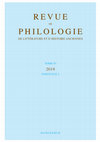
Revue de philologie, de littérature et d'histoire anciennes, 2019
Cet article reprend le dossier de Μαρδύλας, nom employé dans un mythe sur la fondation de l’oracl... more Cet article reprend le dossier de Μαρδύλας, nom employé dans un mythe sur la fondation de l’oracle de Dodone pour désigner le berger voleur de troupeau qui a tenté d’abattre le chêne oraculaire. Après avoir écarté différentes hypothèses quant à sa formation, notamment celle d’une origine non grecque, il est proposé d’en faire un composé de rection verbale comportant au premier membre le radical de μέρδει· κωλύει, βλάπτει (Hsch.), après traitement dialectal de /er/ en /ar/, et celui de ὕλη au second. Μαρδύλας serait alors un nom parlant ayant le sens de "Qui nuit au bois". Alors que μέρδει est généralement rapproché de ἀμέρδω (< i.-e. *h₂merd-), il est également plausible de le rattacher à la racine *smerd- "faire du mal", attestée dans les adjectifs σμερδνός et σμερδαλέος. Dans une dernière section est examiné le petit groupe d’anthroponymes formés sur μερδ- et σμερδ-, mais aussi ceux reposant sur σμορδ-.
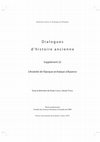
L’Anatolie: de l’époque archaïque à Byzance (éd. A. Lamesa, G. Traina), Dialogues d'histoire ancienne Suppl. 22, 2021
RÉSUMÉ – En tant que langue du pouvoir achéménide, l’araméen a, en Lycie, un statut clair, celui ... more RÉSUMÉ – En tant que langue du pouvoir achéménide, l’araméen a, en Lycie, un statut clair, celui de langue officielle centrale, tandis que le lycien demeure la langue de communication et celle du pouvoir local. Le grec, lui, attesté en Lycie dès le Ve siècle av. J.-C., est d’abord indissociable du genre poétique et c’est à ce titre qu’il est utilisé dans des inscriptions publiques par les dynastes lyciens. Ensuite, une fois la Lycie rattachée à la satrapie carienne, le grec accède au statut de langue officielle, à côté du lycien. Dès lors, comme au sein des élites cariennes, il est également employé dans des inscriptions privées bilingues, dont la composition révèle quelques cas d’interférence linguistique.
The status of Lycian and Greek in the pre-Hellenistic inscriptions of Lycia.
ABSTRACT – Aramaic is used in Lycia as the official language of the Achaemenid Empire, whereas Lycian remains the main communication language as well as the language of the local power. Greek, attested in Lycia from the 5th century BC onwards, first appears to be inseparable from the poetic genre, which was used by Lycian dynasts in public inscriptions. Then, once Lycia is ruled by the Carian satrapy, Greek becomes an official language, alongside the Lycian. Since then, as among the Carian elites, Greek is also used in private bilingual inscriptions, the composition of which reveals some cases of linguistic interferences.
Revue des Études grecques, 2020
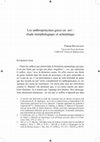
La suffixation des anthroponymes grecs antiques (éd. Alcorac Alonso Déniz, Laurent Dubois, Claire Le Feuvre et Sophie Minon), 2017
Au sein de la littérature, c'est dans la comédie attique que l'on rencontre les premiers témoigna... more Au sein de la littérature, c'est dans la comédie attique que l'on rencontre les premiers témoignages de l'emploi de -ιον avec des anthroponymes. Il faut d'emblée nuancer cette affirmation, puisque, chez Aristophane ces créations relèvent de facteurs pragmatiques : on ne 4. En mycénien, la transcription de ce suffixe serait -jo (noté par le signe 36 du syllabaire), or -jo peut tout aussi bien correspondre au grec alphabétique -ίων ou -ιος qui constituent des finales d'anthroponyme fort courantes. En théorie, donc, rien ne nous autorise à affirmer que la finale -ion n'était pas employée dans les anthroponymes mycéniens, mais c'est précisément -comme on le verra -parce qu'elle n'apparaît pas dans les noms propres du grec alphabétique avant le v e siècle a. C. que des noms comme na-si-jo (KN B 800.3) ou a-di-ri-jo (KN Do 7613.b) sont interprétés de préférence respectivement comme /Nāsios/ et /Andrios/, ce dernier étant attesté sous la forme alphabétique Ἄνδριος plusieurs fois depuis le v e s. a. C. (LGPN 5b, notamment) : voir F. Aura Jorro, Diccionario micénico (sous la dir. de F. R. Adrados), Madrid, 1983-1995, s.v. na-si-jo et a-di-ri-jo. les noms en -ιον : morphologie et sémantique 381 rencontre pas à proprement parler de noms de personnes en -ιον, mais des créations expressives ponctuelles, circonscrites à des situations dramatiques spécifiques. Ces créations apparaissent toujours dans le cadre d'apostrophes et sont par conséquent au vocatif. Elles sont employées avec une véritable valeur hypocoristique par certains personnages (souvent les mêmes) dans le but de s'attirer les bonnes grâces de leur interlocuteur. C'est un Dicéopolis caressant qui, dans Les Acharniens (404), dérange Euripide en pleine composition en l'appelant Εὐριπίδη, Εὐριπίδιον, « Euripide, mon petit Euripide ! » ou encore un Strepsiade tendre dans Les Nuées (79) qui cherche à éveiller son fils Phidippide pour lui demander une faveur : Φειδιππίδη, Φειδιππίδιον, « Phidippide, Phidippidounet ! ». Ces formations expressives chez Aristophane apparaissent toujours dans des situations semblables : un personnage s'adresse à un autre en associant le suffixe diminutif de genre neutre au nom de ce dernier, en espérant que cette cajolerie lui permettra d'obtenir ce qu'il désire. Ce désir est parfois charnel, comme lorsque Cinésias, dans Lysistrata , implore sa Μύρριον, « Myrrhinette » de venir se coucher auprès de lui, lassé de l'abstinence que celle-ci lui impose. Il convient de préciser que, dans la plupart de ces formations aristophaniennes en -ιον, c'est en réalité la finale -ίδιον qui est employée avec la valeur hypocoristique. Ainsi Dionysos, dans Les Grenouilles tente-t-il d'amadouer Xanthias en l'appelant Ξανθίδιον « Xanthinet » (582), tandis que Strepsiade, qui désire faire descendre Socrate de sa corbeille dans Les Nuées, l'apostrophe ainsi : Ὦ Σώκρατες, ὦ Σωκρατίδιον, « Socrate, Socratounet ! » (222-223). Les personnages d'Aristophane, à l'instar du dramaturge lui-même, n'hésitent pas à jouer avec cette finale -ίδιον : ainsi, Dicéopolis nargue, à la fin des Acharniens, son ancien adversaire Lamachos en remplaçant ironiquement le suffixe -ίδιον par -ίππιον, créant alors Λαμαχίππιον « Laméquinet » (1206), afin de railler sa posture de cavalier sans cheval. Dans les Cavaliers, le Charcutier, dans une apostrophe encore plus mielleuse que les autres à l'attention de Dèmos, opte pour la concaténation unique -ακ-ίδιον dans Δημ-ακ-ίδιον (823), au lieu du Δημ-ίδιον utilisé quelques vers au-dessus (725) ou au-dessous (1199) : on est ici dans la surenchère enjôleuse, que l'on pourrait rendre par « Populonet » 5 . La finale -ίδιον apparaît, dans 5. Je remercie L. Dubois, qui m'a suggéré cette traduction.
Le bon homme Grandgousier beuvant, et se rigolant avecques les aultres entendit le cry horrible q... more Le bon homme Grandgousier beuvant, et se rigolant avecques les aultres entendit le cry horrible que son filz avoit faict entrant en lumiere de ce monde, quand il brasmoit demandant, « à boyre, à boyre », dont il dist « que grand tu as », supple le gousier. Ce que ouyans les assistans, dirent que vrayement il debvoit avoir par ce le nom Gargantua, puis que telle avoit esté la premiere parolle de son pere a sa naissance.
Dissertation by Florian Réveilhac

La Lycie antique, aire de polyglossie située sur la côte sud-occidentale de l’Asie Mineure, fut u... more La Lycie antique, aire de polyglossie située sur la côte sud-occidentale de l’Asie Mineure, fut un lieu de contact entre le lycien et le grec. La langue lycienne, qui appartient au groupe anatolien des langues indo-européennes, est attestée dans deux cents inscriptions environ et sur des monnaies datant du Ve et du IVe siècle avant J.-C. À partir du IIIe siècle, en effet, le grec s’est imposé dans la région, à l’écrit du moins, au détriment de la langue locale. L’onomastique indigène a cependant persisté en Lycie jusqu’aux premiers siècles de notre ère, comme en témoigne le nombre important d’anthroponymes lyciens que l’on trouve dans les inscriptions grecques des époques hellénistique et romaine. Cette thèse étudie donc le contact entre le lycien et le grec à partir des emprunts onomastiques réciproques, avec quatre objectifs principaux. Le premier est de collecter tous les anthroponymes indigènes de Lycie dans les sources lyciennes et grecques, afin d’en offrir un répertoire complet. Nous offrons ensuite une description phonologique et phonétique du lycien à partir des équivalences onomastiques identifiées, en traitant également de problèmes spécifiques comme celui des consonnes géminées. Il s’agit, troisièmement, d’examiner les différentes formations à l’œuvre dans l’anthroponymie lycienne — noms à un radical, à deux radicaux, raccourcis de composés, Satznamen ou encore noms inanalysables — et les lexèmes employés. Nous étudions, enfin, les processus morphologiques de l’emprunt de noms étrangers en lycien, mais aussi et surtout en grec, où plusieurs suffixes sont utilisés.
Conference Presentations by Florian Réveilhac

12th Celtic Conference in Classics, Coimbra 27th June 2019
During the second part of the Ist millennium BC, Lycia, located on the South-Western coast of Asi... more During the second part of the Ist millennium BC, Lycia, located on the South-Western coast of Asia Minor, was a multicultural and a polyglossian area. This period of cultural and linguistic mix is especially visible in the onomastics, where one can find Persian and Greek names written in Lycian, as well as Persian and Lycian names written in Greek, in both public and private inscriptions. Lycia remained within the Achaemenid Empire until the Macedonian troops, led by Alexander, invaded it in 334-333 BC. From that moment onwards, there is no more inscription in Lycian: Greek became the only official language. However, the indigenous personal names kept surviving for an exceptionally long period in the Greek inscriptions of Lycia, until the first centuries AD.
Personal names are therefore an inestimable linguistic material for anyone studying Lycian, which is Indo-European language belonging to the Anatolian branch and written between the 5th and the 4th centuries BC in an alphabet probably derived from the Greek alphabet of Rhodes. Given the fragmentary nature of Lycian, collecting properly the Lycian personal names attested in Greek is a necessity, in order to understand better the phonology, the morphology, and the semantics of this language. However, since the Lycian personal names appear in the Greek inscriptions from the 5th century BC onwards to the 4th century AD, their identification does not always have the same degree of certainty. Therefore, the aim of this contribution is to answer the two following questions:
1) How to collect an onomastic material in a polyglossian area, where it is intertwined with personal names of different languages, like Greek, Iranian, and Carian?
2) How to organize it, since these names spread out on nine centuries in different types of inscriptions, with a different reliability regarding their Lycian character?
Thus, I will present the methods I used in collecting the Lycian personal names attested in the Greek inscriptions. First, it is necessary to delimitate the cultural and linguistic area of Lycian, based on archaeological, historical, and linguistic evidences.
Then, among all the data of personal names attested in the Greek inscriptions of this area, one must select the Lycian forms by dismissing those of other origins, mostly Greek, but also Latin, Iranian, or Carian. In previous inventories, some names were inaccurately regarded as Lycian, either because of a wrong reading of the inscription itself, or because of an incorrect interpretation (e.g. Ἕστειος is Greek, built on the theonym Ἑστία or the appellative ἑστία “the hearth”).
It is possible, then, to select the proper Lycian personal names, thanks to the association with those attested in Lycian or in the related languages, like Luwian: e. g. Lyc. Erm̃me-nẽne/i-, litt. “brother of the Moon-god” (cfr. Luw. /Arma-nana/i-/) → Ερμα-νανις, Ερμε-νην(ν)ις. Some personal names, for which the original Lycian form is unknown, are nevertheless linked to an attested Lycian lexeme: e.g. Ζβη-νοβας and Τεδι-σβης both present the lexeme esbe- “horse” associated to another stem, respectively nube- “?” and tede/i- “father”. In other cases, the name can be linked to an Anatolian lexeme, even if it is not yet attested in Lycian: e.g. Luw. /pihassa/i-/ “shining” → Π(ε)ιγασις, Ερ-βιγεσις.
There are also some peculiar cases, as expected in such a context of language contact, starting with translation names: e.g. Χssbezẽ- → Πόρπαξ “handle of a shield”. Our corpus includes also some hybrid names, involving elements of both Lycian and Greek: e.g. Μερι μυθος, with a first Lycian element (cf. Meri-mawa-, Μερι-μαοσσα, Μερι-μαυασσα) and a second Greek element based on μῦθος “word, speech” (cf. Ἀρχί-μυθος, Παρά-μυθος). There are, finally, cover names, which are originally indigenous forms transformed with a Greek shape, so they can be interpreted both in Lycian and in Greek: e.g. Purihimete/i- (unkown meaning) → Πυρι-βατης “the one who walks (-βάτης) in the fire (τὸ πῦρ)”.
The last issue considered in this contribution is about the presentation of the collected material, in order to make it reliable for linguistic purposes. This must reflect indeed the degree of certainty of the identification of the personal names as Lycian.
The first group displays the personal names attested beside their original counterpart in multilingual inscriptions (e.g. Αρτεμηλις ← Erttimeli).
Then are presented those can be easily connected to personal names attested in Lycian, based on thorough phonetic correspondences (Αρμοας/Ερμοας ← Hrm̃muwe-).
The third group contains personal names in which at least one Lycian or Anatolian lexeme can be identified (e.g. Τεδε-νηνις : cfr. tede/i- “father” and nẽne/i- “brother”).
In the fourth part are gathered together the personal names which are supposedly Lycian, that is, which are not Greek, Iranian, Latin, Carian, nor Phrygian (e.g. Σολαμις).
The last group displays the unanalysable personal names, mostly Lallnamen, which are very common in Asia Minor, but not specifically Lycian (e.g. Λαλλα).

Berner Altorientalisches Forum, June 11th-12th 2019
Although most of the indigenous personal names persisted in Lycia until the first centuries A.D.,... more Although most of the indigenous personal names persisted in Lycia until the first centuries A.D., as evidenced by their large number found in Greek inscriptions from the Hellenistic and Roman periods, some of them underwent a little transformation in order to look like Greek names. This process, which is common in a context of language contact, consists in adopting a homophonic or phonetically similar name or element of the name, called “cover name” or, in French, “nom d’assonance” (see Dondin-Payre and Raepsaet-Charlier 2001; Coşkun and Zeidler 2005). One famous example of this type of onomastic adaptation from one language to another is the name of the Mede general who invaded Asia Minor, known in the Greek sources as Ἅρπαγος (Harpagos): the underlying Iranian name is derived from the adjective arba- “small, young” (cf. Sanskrit arbha-) with the hypocoristic suffix -ka-, but it has been slightly modified in its Greek adaptation in order to get it closer to the Greek substantive ἁρπαγή (harpagē) “pillaging”, so the enemy conqueror is reduced to a simple plunderer.
Some Lycian names are adapted as cover names in Greek, like Purihimeti ⁓ Πυριβάτης, with a second element -βάτης (-batēs), cf. verb βαίνω (bainō) “to walk”, and well attested in typical Greek personal names (Bechtel 1917: 92). The other names that are interpreted are Kuprlle/i- ⁓ Κοπριλις (Koprilis) / Κύβερνις (Kubernis), and Xddazada- ⁓ Κτασασας (Ktasadas), cf. Κτᾱσι- / Κτησι- (Ktāsi- / Ktēsi-).
Handout, conference "Beyond All Boundaries: Anatolia in the 1st Millennium BC" organised by Annic... more Handout, conference "Beyond All Boundaries: Anatolia in the 1st Millennium BC" organised by Annick Payne and Jorit Wintjes, Ascona, 17-22 juin 2018
Journée d’étude "L’Anatolie : de l’époque archaïque à Byzance", Université Paris-Sorbonne - 18 no... more Journée d’étude "L’Anatolie : de l’époque archaïque à Byzance", Université Paris-Sorbonne - 18 novembre 2014
Uploads
Books by Florian Réveilhac
Papers by Florian Réveilhac
In Lycia, an area of language contact especially between Lycian and Greek, indigenous personal names were subject to different strategies of adaptation from the source language to the target language (proper loanword, assimilated loanword, loanshift and cover name). Following seminal works in other contact areas of the Greco-Roman world, this contribution examines the question of Lycian-Greek cover names, i.e. that can be interpreted as Lycian and Greek at the same time. Firstly, it aims to establish identification criteria for these personal names, taking into account the specificities of the Lycian area. It then proposes, through the study of specific cases, a typology of Lycian-Greek cover names which takes into consideration both the point of view of the source language and that of the target language.
The status of Lycian and Greek in the pre-Hellenistic inscriptions of Lycia.
ABSTRACT – Aramaic is used in Lycia as the official language of the Achaemenid Empire, whereas Lycian remains the main communication language as well as the language of the local power. Greek, attested in Lycia from the 5th century BC onwards, first appears to be inseparable from the poetic genre, which was used by Lycian dynasts in public inscriptions. Then, once Lycia is ruled by the Carian satrapy, Greek becomes an official language, alongside the Lycian. Since then, as among the Carian elites, Greek is also used in private bilingual inscriptions, the composition of which reveals some cases of linguistic interferences.
Dissertation by Florian Réveilhac
Conference Presentations by Florian Réveilhac
Personal names are therefore an inestimable linguistic material for anyone studying Lycian, which is Indo-European language belonging to the Anatolian branch and written between the 5th and the 4th centuries BC in an alphabet probably derived from the Greek alphabet of Rhodes. Given the fragmentary nature of Lycian, collecting properly the Lycian personal names attested in Greek is a necessity, in order to understand better the phonology, the morphology, and the semantics of this language. However, since the Lycian personal names appear in the Greek inscriptions from the 5th century BC onwards to the 4th century AD, their identification does not always have the same degree of certainty. Therefore, the aim of this contribution is to answer the two following questions:
1) How to collect an onomastic material in a polyglossian area, where it is intertwined with personal names of different languages, like Greek, Iranian, and Carian?
2) How to organize it, since these names spread out on nine centuries in different types of inscriptions, with a different reliability regarding their Lycian character?
Thus, I will present the methods I used in collecting the Lycian personal names attested in the Greek inscriptions. First, it is necessary to delimitate the cultural and linguistic area of Lycian, based on archaeological, historical, and linguistic evidences.
Then, among all the data of personal names attested in the Greek inscriptions of this area, one must select the Lycian forms by dismissing those of other origins, mostly Greek, but also Latin, Iranian, or Carian. In previous inventories, some names were inaccurately regarded as Lycian, either because of a wrong reading of the inscription itself, or because of an incorrect interpretation (e.g. Ἕστειος is Greek, built on the theonym Ἑστία or the appellative ἑστία “the hearth”).
It is possible, then, to select the proper Lycian personal names, thanks to the association with those attested in Lycian or in the related languages, like Luwian: e. g. Lyc. Erm̃me-nẽne/i-, litt. “brother of the Moon-god” (cfr. Luw. /Arma-nana/i-/) → Ερμα-νανις, Ερμε-νην(ν)ις. Some personal names, for which the original Lycian form is unknown, are nevertheless linked to an attested Lycian lexeme: e.g. Ζβη-νοβας and Τεδι-σβης both present the lexeme esbe- “horse” associated to another stem, respectively nube- “?” and tede/i- “father”. In other cases, the name can be linked to an Anatolian lexeme, even if it is not yet attested in Lycian: e.g. Luw. /pihassa/i-/ “shining” → Π(ε)ιγασις, Ερ-βιγεσις.
There are also some peculiar cases, as expected in such a context of language contact, starting with translation names: e.g. Χssbezẽ- → Πόρπαξ “handle of a shield”. Our corpus includes also some hybrid names, involving elements of both Lycian and Greek: e.g. Μερι μυθος, with a first Lycian element (cf. Meri-mawa-, Μερι-μαοσσα, Μερι-μαυασσα) and a second Greek element based on μῦθος “word, speech” (cf. Ἀρχί-μυθος, Παρά-μυθος). There are, finally, cover names, which are originally indigenous forms transformed with a Greek shape, so they can be interpreted both in Lycian and in Greek: e.g. Purihimete/i- (unkown meaning) → Πυρι-βατης “the one who walks (-βάτης) in the fire (τὸ πῦρ)”.
The last issue considered in this contribution is about the presentation of the collected material, in order to make it reliable for linguistic purposes. This must reflect indeed the degree of certainty of the identification of the personal names as Lycian.
The first group displays the personal names attested beside their original counterpart in multilingual inscriptions (e.g. Αρτεμηλις ← Erttimeli).
Then are presented those can be easily connected to personal names attested in Lycian, based on thorough phonetic correspondences (Αρμοας/Ερμοας ← Hrm̃muwe-).
The third group contains personal names in which at least one Lycian or Anatolian lexeme can be identified (e.g. Τεδε-νηνις : cfr. tede/i- “father” and nẽne/i- “brother”).
In the fourth part are gathered together the personal names which are supposedly Lycian, that is, which are not Greek, Iranian, Latin, Carian, nor Phrygian (e.g. Σολαμις).
The last group displays the unanalysable personal names, mostly Lallnamen, which are very common in Asia Minor, but not specifically Lycian (e.g. Λαλλα).
Some Lycian names are adapted as cover names in Greek, like Purihimeti ⁓ Πυριβάτης, with a second element -βάτης (-batēs), cf. verb βαίνω (bainō) “to walk”, and well attested in typical Greek personal names (Bechtel 1917: 92). The other names that are interpreted are Kuprlle/i- ⁓ Κοπριλις (Koprilis) / Κύβερνις (Kubernis), and Xddazada- ⁓ Κτασασας (Ktasadas), cf. Κτᾱσι- / Κτησι- (Ktāsi- / Ktēsi-).
In Lycia, an area of language contact especially between Lycian and Greek, indigenous personal names were subject to different strategies of adaptation from the source language to the target language (proper loanword, assimilated loanword, loanshift and cover name). Following seminal works in other contact areas of the Greco-Roman world, this contribution examines the question of Lycian-Greek cover names, i.e. that can be interpreted as Lycian and Greek at the same time. Firstly, it aims to establish identification criteria for these personal names, taking into account the specificities of the Lycian area. It then proposes, through the study of specific cases, a typology of Lycian-Greek cover names which takes into consideration both the point of view of the source language and that of the target language.
The status of Lycian and Greek in the pre-Hellenistic inscriptions of Lycia.
ABSTRACT – Aramaic is used in Lycia as the official language of the Achaemenid Empire, whereas Lycian remains the main communication language as well as the language of the local power. Greek, attested in Lycia from the 5th century BC onwards, first appears to be inseparable from the poetic genre, which was used by Lycian dynasts in public inscriptions. Then, once Lycia is ruled by the Carian satrapy, Greek becomes an official language, alongside the Lycian. Since then, as among the Carian elites, Greek is also used in private bilingual inscriptions, the composition of which reveals some cases of linguistic interferences.
Personal names are therefore an inestimable linguistic material for anyone studying Lycian, which is Indo-European language belonging to the Anatolian branch and written between the 5th and the 4th centuries BC in an alphabet probably derived from the Greek alphabet of Rhodes. Given the fragmentary nature of Lycian, collecting properly the Lycian personal names attested in Greek is a necessity, in order to understand better the phonology, the morphology, and the semantics of this language. However, since the Lycian personal names appear in the Greek inscriptions from the 5th century BC onwards to the 4th century AD, their identification does not always have the same degree of certainty. Therefore, the aim of this contribution is to answer the two following questions:
1) How to collect an onomastic material in a polyglossian area, where it is intertwined with personal names of different languages, like Greek, Iranian, and Carian?
2) How to organize it, since these names spread out on nine centuries in different types of inscriptions, with a different reliability regarding their Lycian character?
Thus, I will present the methods I used in collecting the Lycian personal names attested in the Greek inscriptions. First, it is necessary to delimitate the cultural and linguistic area of Lycian, based on archaeological, historical, and linguistic evidences.
Then, among all the data of personal names attested in the Greek inscriptions of this area, one must select the Lycian forms by dismissing those of other origins, mostly Greek, but also Latin, Iranian, or Carian. In previous inventories, some names were inaccurately regarded as Lycian, either because of a wrong reading of the inscription itself, or because of an incorrect interpretation (e.g. Ἕστειος is Greek, built on the theonym Ἑστία or the appellative ἑστία “the hearth”).
It is possible, then, to select the proper Lycian personal names, thanks to the association with those attested in Lycian or in the related languages, like Luwian: e. g. Lyc. Erm̃me-nẽne/i-, litt. “brother of the Moon-god” (cfr. Luw. /Arma-nana/i-/) → Ερμα-νανις, Ερμε-νην(ν)ις. Some personal names, for which the original Lycian form is unknown, are nevertheless linked to an attested Lycian lexeme: e.g. Ζβη-νοβας and Τεδι-σβης both present the lexeme esbe- “horse” associated to another stem, respectively nube- “?” and tede/i- “father”. In other cases, the name can be linked to an Anatolian lexeme, even if it is not yet attested in Lycian: e.g. Luw. /pihassa/i-/ “shining” → Π(ε)ιγασις, Ερ-βιγεσις.
There are also some peculiar cases, as expected in such a context of language contact, starting with translation names: e.g. Χssbezẽ- → Πόρπαξ “handle of a shield”. Our corpus includes also some hybrid names, involving elements of both Lycian and Greek: e.g. Μερι μυθος, with a first Lycian element (cf. Meri-mawa-, Μερι-μαοσσα, Μερι-μαυασσα) and a second Greek element based on μῦθος “word, speech” (cf. Ἀρχί-μυθος, Παρά-μυθος). There are, finally, cover names, which are originally indigenous forms transformed with a Greek shape, so they can be interpreted both in Lycian and in Greek: e.g. Purihimete/i- (unkown meaning) → Πυρι-βατης “the one who walks (-βάτης) in the fire (τὸ πῦρ)”.
The last issue considered in this contribution is about the presentation of the collected material, in order to make it reliable for linguistic purposes. This must reflect indeed the degree of certainty of the identification of the personal names as Lycian.
The first group displays the personal names attested beside their original counterpart in multilingual inscriptions (e.g. Αρτεμηλις ← Erttimeli).
Then are presented those can be easily connected to personal names attested in Lycian, based on thorough phonetic correspondences (Αρμοας/Ερμοας ← Hrm̃muwe-).
The third group contains personal names in which at least one Lycian or Anatolian lexeme can be identified (e.g. Τεδε-νηνις : cfr. tede/i- “father” and nẽne/i- “brother”).
In the fourth part are gathered together the personal names which are supposedly Lycian, that is, which are not Greek, Iranian, Latin, Carian, nor Phrygian (e.g. Σολαμις).
The last group displays the unanalysable personal names, mostly Lallnamen, which are very common in Asia Minor, but not specifically Lycian (e.g. Λαλλα).
Some Lycian names are adapted as cover names in Greek, like Purihimeti ⁓ Πυριβάτης, with a second element -βάτης (-batēs), cf. verb βαίνω (bainō) “to walk”, and well attested in typical Greek personal names (Bechtel 1917: 92). The other names that are interpreted are Kuprlle/i- ⁓ Κοπριλις (Koprilis) / Κύβερνις (Kubernis), and Xddazada- ⁓ Κτασασας (Ktasadas), cf. Κτᾱσι- / Κτησι- (Ktāsi- / Ktēsi-).
Entrée libre dans la limite des places disponibles: pour les auditeurs externes à Sorbonne Université, prière de s'inscrire avant le 27 mai à l'adresse suivante: florian.reveilhac@gmail.com
As we have chosen to open LGPN-Ling while some of the data, only primo-edited, is still being studied or revised, it will be essential to cite any personal name record you use, indicating the date of its last update. Questions, suggestions, criticisms or additions are of course welcome and can be sent to the contact address indicated on the site.
Warning: at the moment, please do not use Safari to visit it, but rather any other browser.